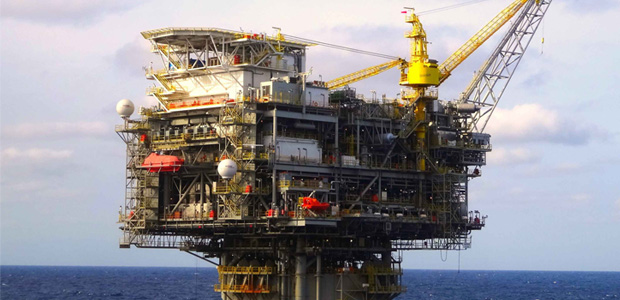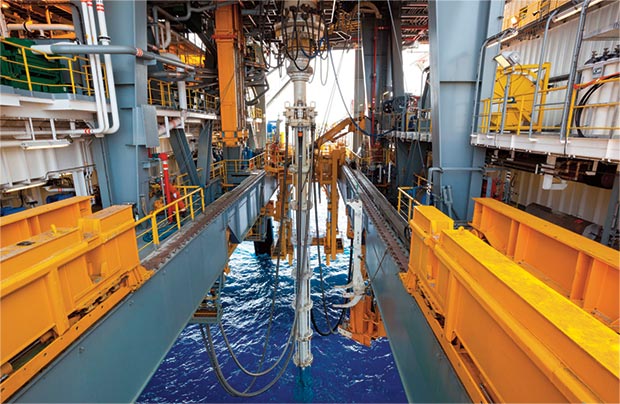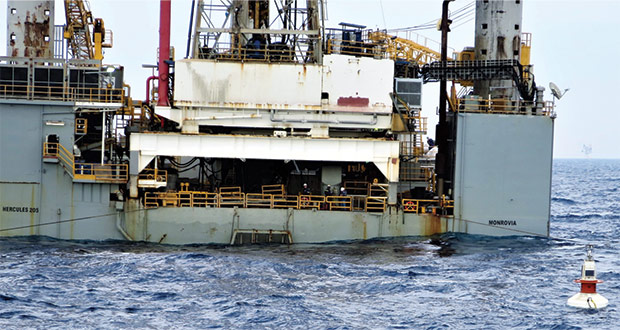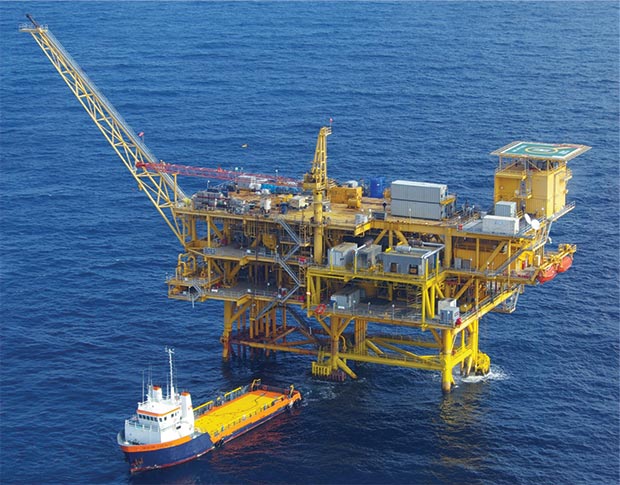
Offshore Update
Gulf Of Mexico’s Superior Geology Translates Into Profitable Projects
By Al Pickett, Special Correspondent
According to Danny Brown, Anadarko Petroleum Corporation’s senior vice president of international and deepwater operations, in addition to its oil-producing international assets and ongoing exploration program, the company has a “3D” focus that consists of the deepwater Gulf of Mexico, the Delaware Basin in West Texas and the Denver-Julesburg Basin in Colorado.
Anadarko announced in August that it had acquired Freeport-McMoRan’s deepwater assets, which Brown claims offer a tremendous opportunity for not only its Gulf operations, but the entire corporate portfolio. “We were able to pick up these assets for 1.5 times next year’s cash flow,” Brown enthuses. “We are uniquely positioned in the Gulf and very comfortable operating there. It is a way for us to bolt on to our existing blocks, and offers us a fantastic growth opportunity.”
He says the Freeport-McMoRan acquisition will bring Anadarko an expected $3 billion in cash flow during the next five years, and much of that revenue will be pushed back into developing the company’s onshore properties in the Delaware and DJ basins.
The acquisition provides Anadarko a number of other benefits, Brown considers, as it has doubled the company’s ownership in the Lucius development to 49 percent. It also has doubled Anadarko’s Gulf of Mexico production to more than 160,000 net barrels of oil equivalent a day. Because the acquired production is 85 percent oil, Brown indicates, it should provide the company with a higher margin on its development.
Finally, the acquisition adds three operated deepwater facilities, bringing Anadarko’s total to 10 operated floating production facilities spread across the Gulf. That infrastructure gives Anadarko a “very low cost of development and makes tiebacks attractive,” he maintains.
“Green field developments are much more challenging without existing infrastructure,” Brown adds.
By acquiring more than 80 deepwater blocks from Freeport-McMoRan, Anadarko Petroleum Corp. has doubled its Gulf of Mexico production to 160,000 net barrels of oil equivalent a day. The acquisition’s three operated deepwater facilities also give Anadarko a total of 10 operated floating production facilities in the Gulf.
An Exciting Time
According to Anadarko, acquiring upward of 80 blocks from Freeport-McMoRan has expanded Anadarko’s Gulf of Mexico portfolio of working interest blocks to more than 350, making it the Gulf’s top operator. Anadarko also has announced successes at the Warrior and Phobos discoveries, which add to its inventory of future tieback opportunities, and it reports a successful development well in the Heidelberg Field.
According to Brown, the Warrior exploration well, which was drilled in 4,400 feet of water about three miles from the Anadarko-operated K2 Field, encountered more than 210 feet of oil pay in multiple high-quality Miocene-aged reservoirs. Anadarko is the operator at Warrior with a 65 percent working interest.
“It is a likely tie back to our Marco Polo production facility,” he notes. “We have a number of these opportunities. Eight of our 10 operated production facilities have room to put more wells on line, and there is also the potential to expand them. That cuts the cost and time of new development.”
Brown contends the production facilities also give Anadarko the opportunity to gain additional equity in other prospects as well as the opportunity to leverage into a production solution for other companies, which would keep its facilities full and operating at a lower cost. “It is a win-win opportunity for both Anadarko and other companies operating in the region,” he considers.
As an example, the company cites its Lucius facility, which was able to process Exxon-Mobil’s production from its Hadrian Field, highlighting the flexibility the production facilities afford.
At the Phobos appraisal well, located 12 miles south of the Lucius facility, Brown says Anadarko already has encountered more than 90 net feet of high-quality oil pay in Pliocene-aged reservoirs similar to the Lucius Field. He explains this secondary accumulation was present in the Phobos discovery well, and Anadarko will evaluate it for tieback to the Lucius facility. Meanwhile, Brown indicates, drilling toward the primary objective in the Wilcox formation continues. Anadarko has a 100 percent working interest at Phobos.
At the Heidelberg Field, a fifth production well has encountered reservoir sand with more than 150 net feet of oil pay. “It will tie back to our Heidelberg facility, and we expect new production from that fifth well early this year,” Brown offers. “We have other opportunities, too. That is not unique to Heidelberg, either. This is an exciting time for our Gulf of Mexico team.”
Successful Strategy
For 25 years, the founders of Byron Energy Ltd., a small Australian independent, have found success by going into the Gulf of Mexico’s old producing areas, describes Chief Executive Officer Maynard Smith. “The model has worked well,” he characterizes. “We have had a good career following the majors.”
The approach involves more than going into heavily explored regions, however. Smith says his company also specializes in unlocking structurally complex areas. “We have drilled 114 wells with a success rate better than 83 percent since we first started drilling in the Gulf in 1993,” he recounts. “We always use the best geophysics.”
According to Smith, Byron Energy’s latest discovery encapsulates the company’s strategy perfectly. The company announced in spring 2016 that its SM71 No. 1 well had reached a final total depth of 7,477 feet in the South Marsh Island Block 71. The discovery, on the block’s western flank, is in 130 feet of water off the Louisiana coast.
He says the well’s deeper portion encountered a 19-foot true vertical thickness depth (TVT) hydrocarbon-bearing sand, adding to the 132 feet TVT of net oil pay in three other zones indicated by porosity logs.
Byron Energy Ltd. has hit on 83 percent of the 114 wells it has drilled in the U.S. Gulf since 1993. In an effort to hone its inversion model, the company has acquired acoustic shear wave data that it hopes will illuminate seismic responses in both hydrocarbon and wet sands in the area near its wells.
“We are very pleased to encounter our fourth hydrocarbon interval in this wellbore,” Smith said in May. “This is the first time in my career I have seen four sands trap hydrocarbons stratigraphically in one wellbore. Every predrill target sand, both primary and secondary, has been found to have hydrocarbons. These stratigraphic traps were found using high-resolution, second-generation reverse time seismic migration, and in conjunction with a very advanced seismic inversion model.
“To further enhance and fine-tune our inversion model, we acquired acoustic shear wave data over all the objective sands in this wellbore,” he added. “These data will be key to understanding the seismic responses in both hydrocarbon and wet sands in the area. The shear log is the first shear wave data collected in more than 320 wells on the SM71 dome, where 117 million barrels (of oil) and 377 billion cubic feet of gas already have been produced. We believe this information will give Byron a significant advantage in exploring for and exploiting other stratigraphic traps on our blocks, and other blocks on the dome.”
Smith marvels that Bryon Energy can find a field with an estimated ultimate recovery of 5 million barrels at a depth of only 6,000 feet in such a heavily explored area. “This is advanced stuff,” he characterizes, noting the field was discovered in a structurally complex area under a salt dome with a deep updip. “This is totally technologically driven, using cutting edge technology. Discoveries in the transition oil zone–both on- and offshore–are driven by big advances in geophysics.”
The SM71 No. 1 is the second well drilled as part of Bryon’s farm-out to Otto Energy Ltd., another small Australian independent, which has a 50 percent working interest in South Marsh Island Blocks 70 and 71. Byron Energy is the operator.
Smith says 80 percent of its investors are Australian, but 100 percent of its money is spent in the Gulf of Mexico. “The Gulf has the best geology anywhere,” he acclaims. “Experimental geophysics starts in the Gulf because we know the rocks so well. America is a great place to be an entrepreneur. In Australia, three or four companies hold most of the land. Here, you can go to a lease sale and if you have the high bid, you can go to work.”
Smith calls the SM71 a “multiwell discovery,” and indicates Byron Energy has entered a purchase and construction agreement for a six-slot tripod jacket with decks and production equipment for its development. Laredo Construction in Stafford, Tx., is refurbishing the tripod, which will include decks, a helideck, a boat landing and production equipment, and will provide turnkey installation of the tripod once the work is complete and permits are approved.
The tripod facility, which is being refurbished, modified and installed for a gross cost of $9 million, can accommodate six wells and will be capable of producing as much as 5,000 bbl/d, along with associated natural gas, Smith details.
He predicts production will begin late in the third quarter or early in the fourth quarter of 2017, adding that the company may drill a second well before year’s end. Other projects he mentions include plans to drill onshore near the mouth of Louisiana’s Atchafalaya River.
Even amid 2016’s lackluster commodity prices, Smith says the Gulf of Mexico remains a profitable basin. “Everybody left the Gulf too early, which is fine with us,” he holds. “At $3.50 gas and $50 oil, the Gulf is still one of the more attractive areas. A little company like ours can put in a well and have success here.”
W&T Offshore has achieved a 100 percent drilling success rate over the past three years in the Gulf, including the Ship Shoal 349 A-18, a deep Shelf subsalt well that was drilled to a total vertical depth of approximately 20,000 feet in 372 feet of water on the western side of the Mahogany Field. The A-18 well commenced production on Jan. 17 and is producing at a daily rate of 5,217 boe (4,032 barrels of oil and 7.1 MMcf of gas). With a 2017 capital budget of $125 million, W&T Offshore plans to drill six to eight wells this year, including a new well at its Viosca Knoll 823 Virgo Field.
Going Deeper
As W&T Offshore Inc. drills in 372 feet of water in the Mahogany Field, about 100 miles south of New Orleans, it is exploring much deeper horizons, reports Chairman and CEO Tracy W. Krohn.
According to Krohn, the company expects to bring the A-18 well in Ship Shoal Block 349 on line early this year. Drilled to a total depth of 18,722 feet, it targets the “T” sand, but Krohn suggests that extending the wellbore to nearly 20,000 feet will allow it to also encounter the oil-producing “U” sand.
He credits improved imaging as a key to discovering the deeper sands. “We are drilling the Ship Shoal 349 A-18 development well, targeting the T sand that has produced so prolifically in the field’s A-14 well since mid-2013,” Krohn details. “We will complete the T sand first and then see where we go with the U sand. It could be an important discovery.”
W&T Offshore initially purchased an interest in the Mahogany Field in 2004, and now owns 100 percent of it, he indicates. “It is interesting to watch the progression of data since we took over the field,” Krohn marvels. “We are big believers in data. The data quality is one reason I like working offshore. There is little noise on the water compared with the land and not as much interference. As a result, we are able to image better, even under the salt. Apparently, we haven’t gotten to the bottom yet.”
The downturn prompted the company to stack the rig it was using to drill the Mahogany Field, he relates, but it resumed activity last fall. “We put it back to work when prices starting coming back up,” Krohn relates. “During the industry downturn, we remained focused on evaluating the drilling and production data from certain other wells, as well as the advanced seismic data we had acquired and interpreted to help us better understand Mahogany’s subsalt opportunities.
“Additionally, we have planned a number of recompletion and workover opportunities, including two workovers at Mahogany, which offer low risk and solid returns from wells that were drilled in stacked reservoirs with multiple pay zones,” he continues. “These projects help us maintain our profile with a modest capital budget.”
In addition to handling its own production, Krohn says, the company’s Mahogany platform also is handling some production from other companies.
Last fall, W&T Offshore also recompleted the A-1 well at Viosca Knoll 823 “Virgo” and the Ewing Bank 954 A-8 well. According to Krohn, both wells have exceeded expectations, with production rates of 4,400 boe a day gross and 3,200 boe/d net in the fourth quarter. “We are continuing our work in the Ewing Bank Field, and our intent is to drill a new Virgo well, hopefully in 2017,” he says.
The Virgo wells are in about 1,100 feet of water, and the Ewing Bank wells are in more than 600 feet of water, he details.
“There is still more to do,” Krohn acknowledges. “I think 2017 will see us return to a more normal operational state, buying more property and drilling new wells.”
For other great articles about exploration, drilling, completions and production, subscribe to The American Oil & Gas Reporter and bookmark www.aogr.com.


















